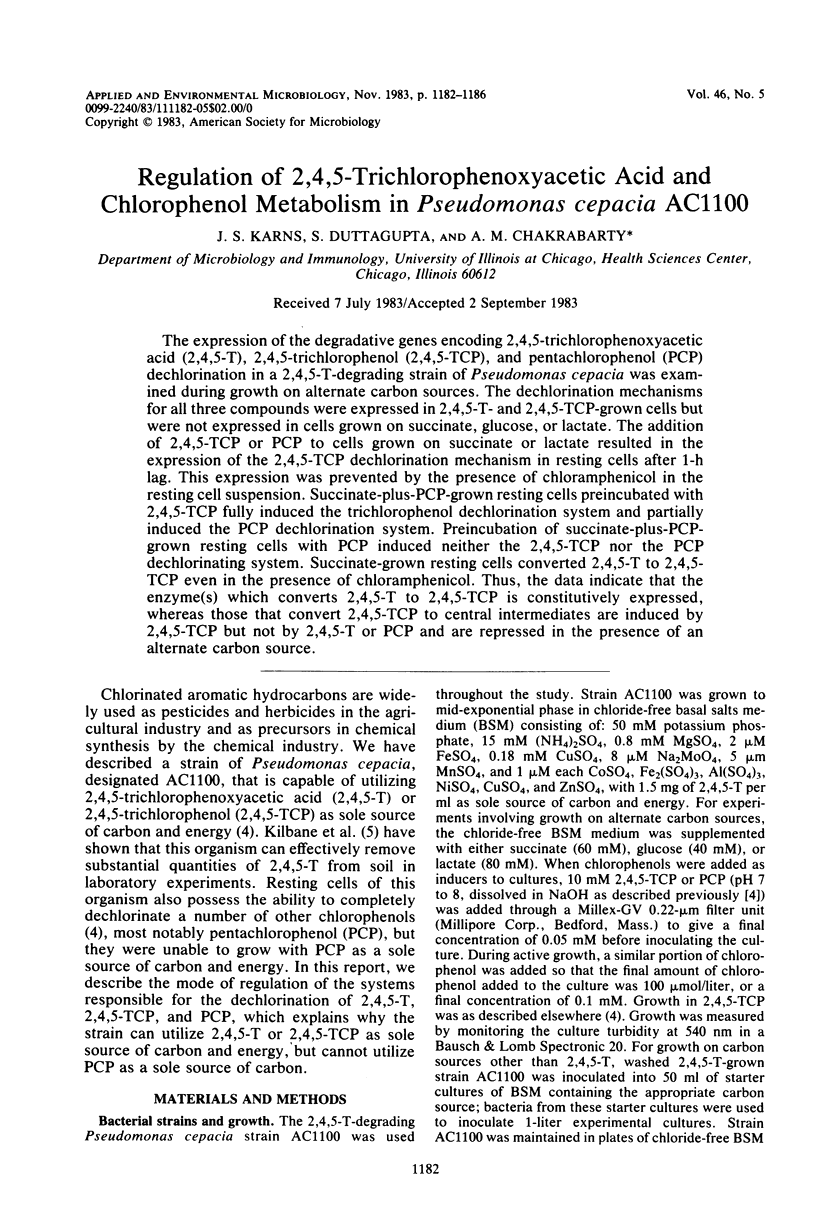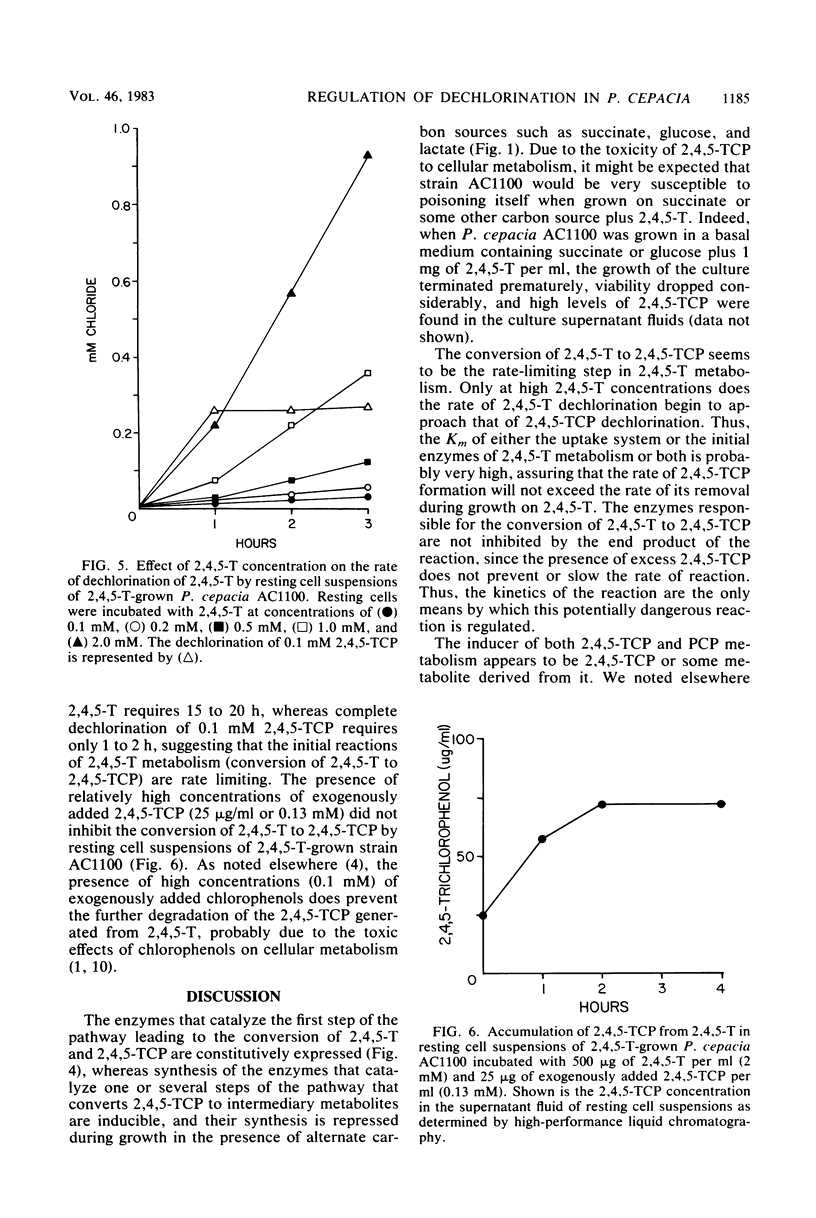Abstract
The expression of the degradative genes encoding 2,4,5-trichlorophenoxyacetic acid (2,4,5-T), 2,4,5-trichlorophenol (2,4,5-TCP), and pentachlorophenol (PCP) dechlorination in a 2,4,5-T-degrading strain of Pseudomonas cepacia was examined during growth on alternate carbon sources. The dechlorination mechanisms for all three compounds were expressed in 2,4,5-T- and 2,4,5-TCP-grown cells but were not expressed in cells grown on succinate, glucose, or lactate. The addition of 2,4,5-TCP or PCP to cells grown on succinate or lactate resulted in the expression of the 2,4,5-TCP dechlorination mechanism in resting cells after 1-h lag. This expression was prevented by the presence of chloramphenicol in the resting cell suspension. Succinate-plus-PCP-grown resting cells preincubated with 2,4,5-TCP fully induced the trichlorophenol dechlorination system and partially induced the PCP dechlorination system. Preincubation of succinate-plus-PCP-grown resting cells with PCP induced neither the 2,4,5-TCP nor the PCP dechlorinating system. Succinate-grown resting cells converted 2,4,5-T to 2,4,5-TCP even in the presence of chloramphenicol. Thus, the data indicate that the enzyme(s) which converts 2,4,5-T to 2,4,5-TCP is constitutively expressed, whereas those that convert 2,4,5-TCP to central intermediates are induced by 2,4,5-TCP but not by 2,4,5-T or PCP and are repressed in the presence of an alternate carbon source.
Full text
PDF




Selected References
These references are in PubMed. This may not be the complete list of references from this article.
- Hylemon P. B., Phibbs P. V., Jr Independent regulation of hexose catabolizing enzymes and glucose transport activity in Pseudomonas aeruginosa. Biochem Biophys Res Commun. 1972 Sep 5;48(5):1041–1048. doi: 10.1016/0006-291x(72)90813-3. [DOI] [PubMed] [Google Scholar]
- Karns J. S., Kilbane J. J., Duttagupta S., Chakrabarty A. M. Metabolism of Halophenols by 2,4,5-trichlorophenoxyacetic acid-degrading Pseudomonas cepacia. Appl Environ Microbiol. 1983 Nov;46(5):1176–1181. doi: 10.1128/aem.46.5.1176-1181.1983. [DOI] [PMC free article] [PubMed] [Google Scholar]
- Kight-Olliff L. C., Fitzgerald J. W. Inhibition of enzyme induction in Pseudomonas aeruginosa by exogenous nucleotides. Can J Microbiol. 1978 Jul;24(7):811–817. doi: 10.1139/m78-136. [DOI] [PubMed] [Google Scholar]
- Kilbane J. J., Chatterjee D. K., Chakrabarty A. M. Detoxification of 2,4,5-trichlorophenoxyacetic acid from contaminated soil by Pseudomonas cepacia. Appl Environ Microbiol. 1983 May;45(5):1697–1700. doi: 10.1128/aem.45.5.1697-1700.1983. [DOI] [PMC free article] [PubMed] [Google Scholar]
- Kilbane J. J., Chatterjee D. K., Karns J. S., Kellogg S. T., Chakrabarty A. M. Biodegradation of 2,4,5-trichlorophenoxyacetic acid by a pure culture of Pseudomonas cepacia. Appl Environ Microbiol. 1982 Jul;44(1):72–78. doi: 10.1128/aem.44.1.72-78.1982. [DOI] [PMC free article] [PubMed] [Google Scholar]
- Midgley M., Dawes E. A. The regulation of transport of glucose and methyl alpha-glucoside in Pseudomonas aeruginosa. Biochem J. 1973 Feb;132(2):141–154. doi: 10.1042/bj1320141. [DOI] [PMC free article] [PubMed] [Google Scholar]
- Siegel L. S., Hylemon P. B., Phibbs P. V., Jr Cyclic adenosine 3',5'-monophosphate levels and activities of adenylate cyclase and cyclic adenosine 3',5'-monophosphate phosphodiesterase in Pseudomonas and Bacteroides. J Bacteriol. 1977 Jan;129(1):87–96. doi: 10.1128/jb.129.1.87-96.1977. [DOI] [PMC free article] [PubMed] [Google Scholar]
- Tiwari N. P., Campbell J. J. Enzymatic control of the metabolic activity of Pseudomonas aeruginosa grown in glucose or succinate media. Biochim Biophys Acta. 1969 Dec 30;192(3):395–401. doi: 10.1016/0304-4165(69)90388-2. [DOI] [PubMed] [Google Scholar]
- Weinbach E. C. BIOCHEMICAL BASIS FOR THE TOXICITY OF PENTACHLOROPHENOL. Proc Natl Acad Sci U S A. 1957 May 15;43(5):393–397. doi: 10.1073/pnas.43.5.393. [DOI] [PMC free article] [PubMed] [Google Scholar]
- Whiting P. H., Midgley M., Dawes E. A. The regulation of transport of glucose, gluconate and 2-oxogluconate and of glucose catabolism in Pseudomonas aeruginosa. Biochem J. 1976 Mar 15;154(3):659–668. doi: 10.1042/bj1540659. [DOI] [PMC free article] [PubMed] [Google Scholar]


